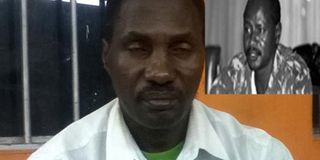When search for loot brought boy face to face with Museveni in 1980

When search for loot brought Tonny Kibuka face to face with Museveni (inset) in 1980. Photo by Henry Lubega.
What you need to know:
Yusuf Lule. In the history of the independent Uganda, he served the shortest term ever, just 68 days after being sworn in. In Witness this week, Tonny Kibuka narrates to Henry Lubega the events following the removal of Prof Yusuf Lule, the first executive Muganda president of Uganda.
At his swearing in on April 13, 1979, he said: “Abaganda kyemwayagaliza embazi kibuyaga asude,” meaning “what the Baganda have been longing for is now a windfall”. It was time for the Baganda “to eat” as well.
Though his presidency was short-lived, on the social scene, it was characterised by excitement, mostly within the central region. However, on June 20, 1979, all these celebrations by the Baganda for having a Muganda president came to an abrupt end when the National Consultative Council (NCC), acting as the parliament at the time, held a special sitting at state House Entebbe and decided to relieve Lule of his duties.
Ugandans react to the news
The late night announcement on Radio Uganda was like a stone in an hornet nest. The next morning, people in their hundreds in Kampala and surrounding areas flocked the streets of Kampala, demanding the restoration of their president. Since it was just barely less than three months after the Tanzanian-led Wakombozi marched onto the streets of Kampala and the looting that followed their entry was so much on the minds of the locals, some people came out with that in mind.
Tonny Kibuka was a 16-year-old resident of Nsambya Estate when the fall of Lule was announced. He and his friend in the neighbourhood set off for Kampala to find whatever they could for themselves following the announcement of the change of government.
“We went to town, thinking we would be able to find some leftovers after looting in some shops and we also help ourselves to them. We walked all the way from Nsambya to City Sqaure in the city centre,” Kibuka narrates.
He continues: “Here, we found many people who had gathered chanting slogans: “No Lule, no work, Ffe twagala Lule oba tufa tufe,” meaning “we want Lule back even if we die”.
Kibuka says they stood on the stairs of City Square directly opposite Africa House. Soldiers stood on the sides monitoring the situation.
“Suddenly, a military jeep emerged from Burton Street and went and parked under a mango tree. It had three occupants, one of whom, as I came to learn later, was Yoweri Museveni, then the Defence minister,” he says, adding: “From a distance, my friend and I could not make sense of what was being discussed. Museveni got off the jeep, talked to the soldiers, went back to the jeep and the three men left. As soon as the jeep disappeared, gunfire rocked the place and people started running in all directions.”
“As we ran down towards the Old Park, we jumped over people with bullet wounds. Others had fallen and got injuries, the scene was very chaotic,” he narrates.
Just a few minutes before the military jeep arrived, Kibuka remembers people were in a different mood, singing slogans in support of the ousted president and all of a sudden, there was pandemonium as people ran for their lives.
With the sudden shooting in Kampala, everybody ran to safety. Kibuka and his friend also dropped the idea of looking for what to loot and ran back home, empty handed.”
The “No Lule, no work” demonstrations claimed a number of lives. The demonstrations were not only restricted to the city centre, they spread to other parts of the city.
The suburbs of Ntinda, Kasubi, Bwaise and Busega among others, saw people taking to the streets demanding to have their president reinstated.
Many, mostly those in Buganda region, accused Tanzanian President Mwalimu Julius Nyerere of having masterminded the removal of Lule.
All in all, the events of that day at the City Square brought Kibuka face to face with a man, who would later turn out to be Uganda’s longest-serving President in his lifetime.




